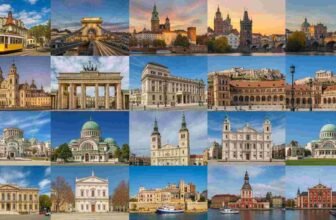
Whispers. That’s how the best coastal escapes are shared—not through glossy brochures or crowded guidebooks, but in hushed tones between travelers who’ve stumbled upon something too good to broadcast.
Europe still holds seaside towns where time slows down, where the beaches sparkle without selfie-stick armies, and where dinner feels like a family gathering rather than a tourist production.
These are the places that make you linger longer than planned, the ones that tug you back in daydreams long after you’ve left. Ready to uncover the shorelines no one brags about but everyone secretly wants to keep? Let’s dive in.
1. Rovinj, Croatia
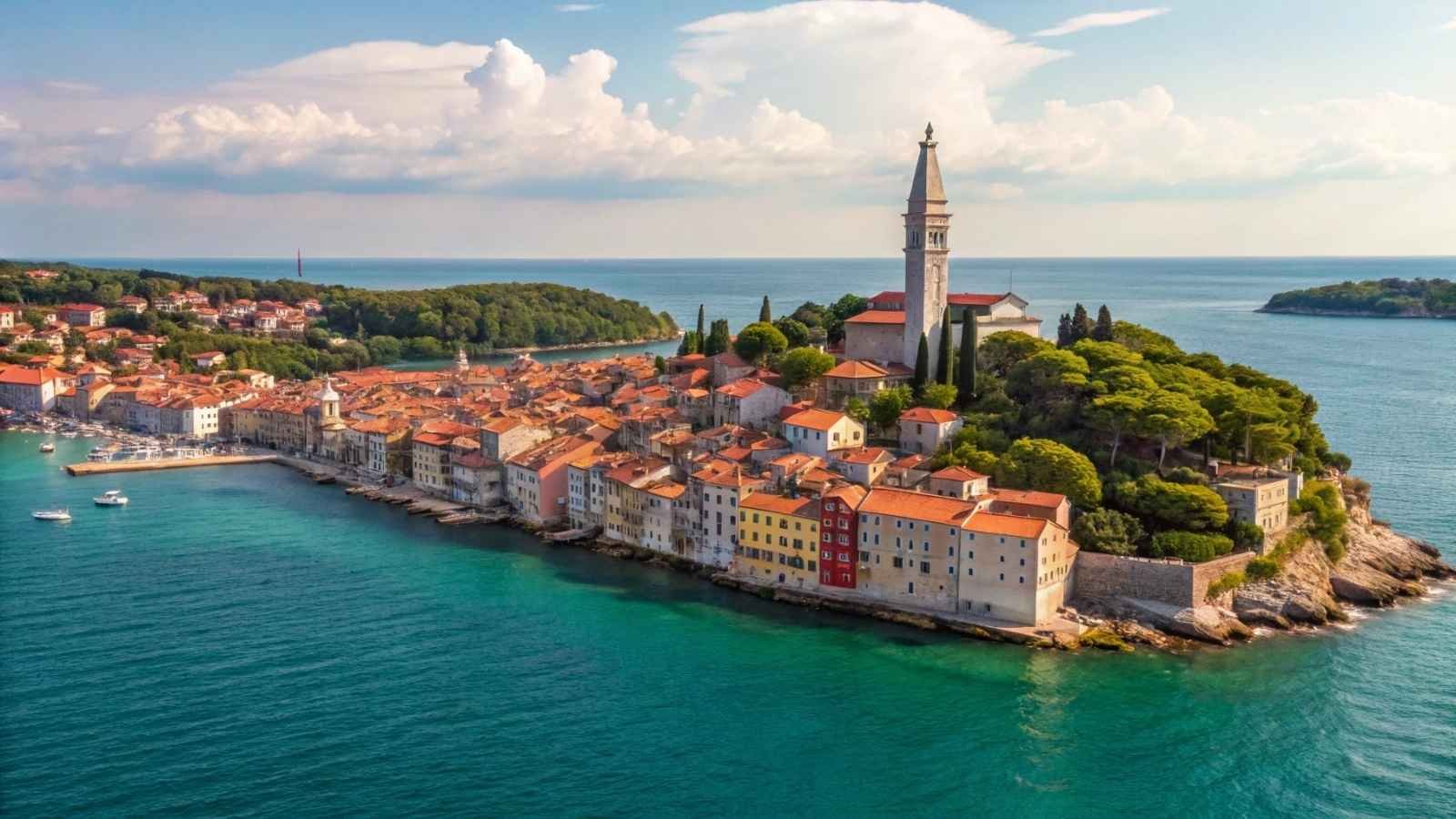
Rovinj feels like it was crafted by artists who refused to let modern life erase its old-world soul. With pastel-colored houses tumbling down to the Adriatic and narrow cobblestone alleys leading to the sea, this town is all about romance and serenity. The harbor hums with fishing boats while locals sip coffee on terraces that seem to float above the water. It’s the kind of place where every stroll feels like a slow uncovering of secrets.
The beaches here aren’t vast stretches of sand, but crystal-clear rocky coves where you can dive straight into turquoise waters. The Old Town sits on a tiny peninsula, so you’re never far from the sea. Beyond the postcard beauty, Rovinj is a working town, meaning it hasn’t been completely polished for tourists—it still breathes with authentic life.
What makes Rovinj special is the balance of culture and coastline. You can spend the morning swimming off the rocks, the afternoon exploring galleries, and the evening dining on truffle pasta as the sun melts into the horizon. Few places in Europe deliver that kind of harmony.
- Best months to visit: May–September (warm waters, fewer crowds in May/June)
- Must-try food: Truffle dishes, fresh Adriatic seafood
- Don’t miss: Sunset from Punta Corrente Park
- Nearest airport: Pula Airport (40 minutes by car)
2. Cefalù, Sicily, Italy
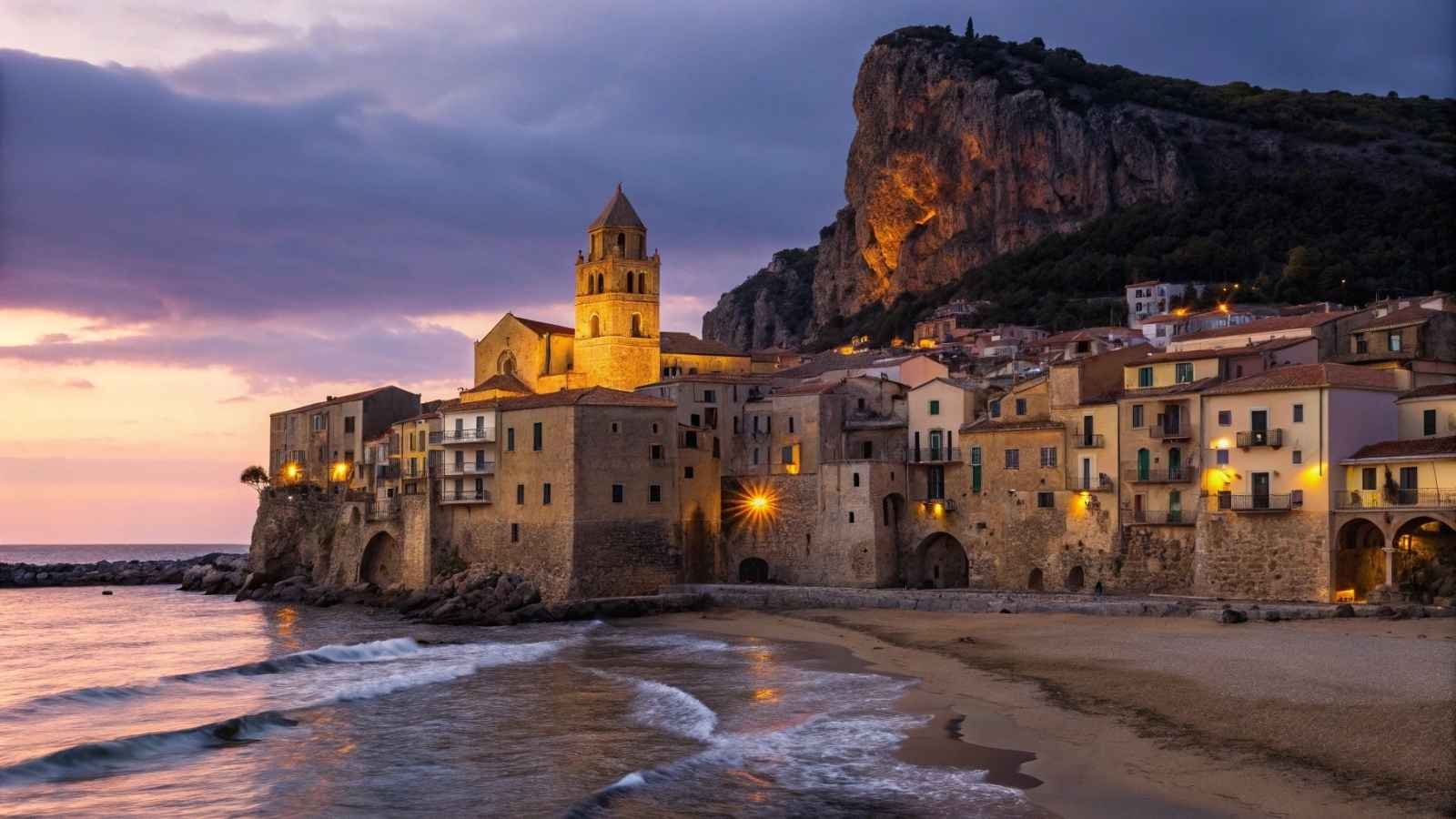
Tucked at the base of a dramatic cliff, Cefalù is a town where golden sand beaches meet medieval charm. Its long crescent beach is among the most beloved in Sicily, with warm, shallow waters perfect for swimming. Yet just a few steps inland, you’re wandering cobblestone streets under the shadow of the Norman cathedral—one of the most impressive in all of Italy.
There’s a rhythm to Cefalù: mornings spent basking in the Mediterranean sun, afternoons exploring hidden lanes and tiny trattorias, evenings with gelato by the sea. The beauty here is both grand and intimate—whether you’re gazing up at the cathedral towers or watching locals gather on the old stone pier.
What makes Cefalù unforgettable is its setting against La Rocca, the towering cliff that dominates the town. A short hike takes you up to sweeping views of rooftops, the cathedral spires, and the endless sea beyond. It’s the kind of view that stays with you long after you’ve left.
- Best months to visit: May, June, September (July/August are hot and crowded)
- Must-try food: Arancini, pasta alla Norma, Sicilian cannoli
- Don’t miss: Sunset from the old pier
- Nearest airport: Palermo Airport (1 hour by train or car)
3. Nazaré, Portugal
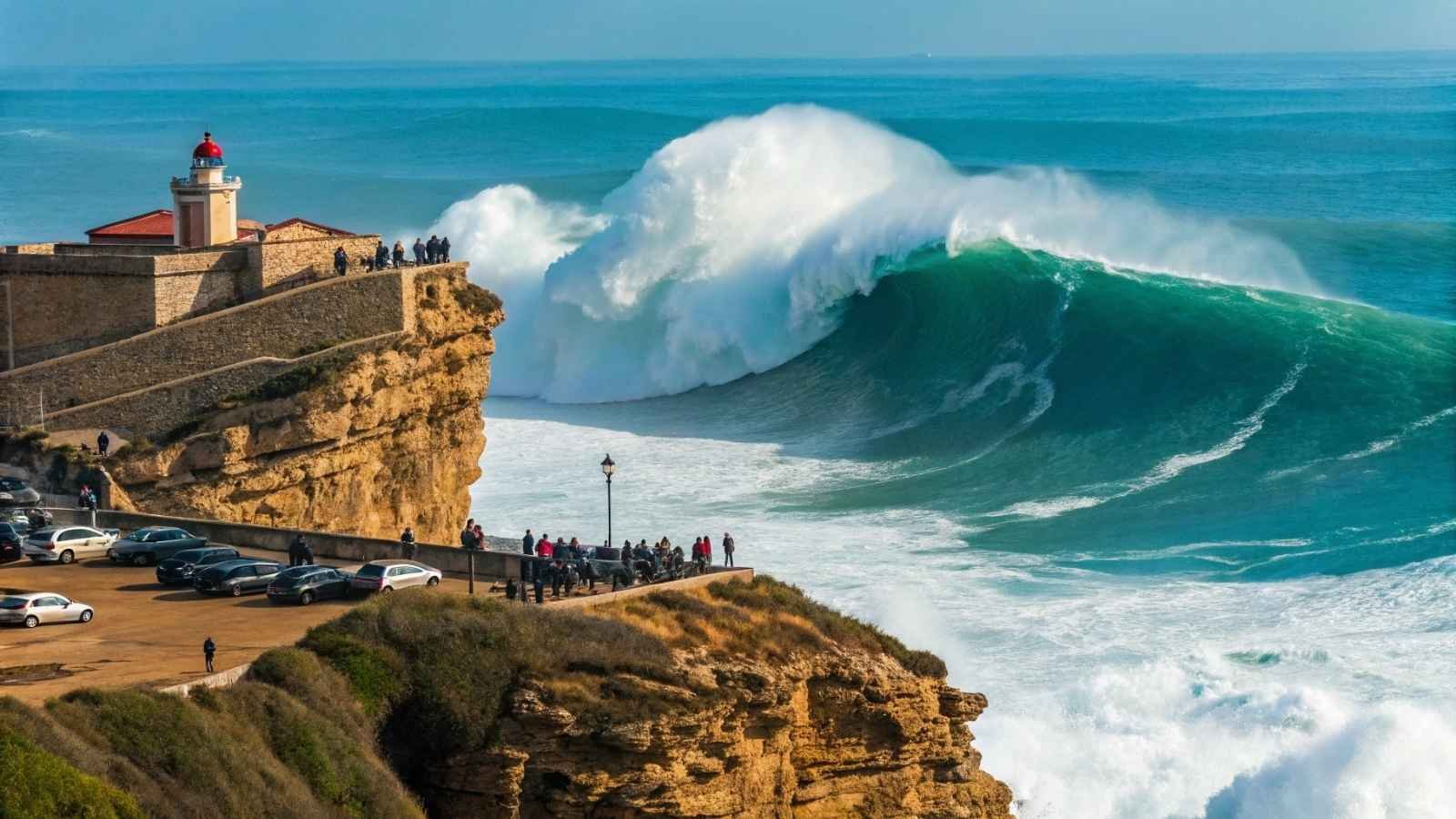
Nazaré has two faces, and both are spectacular. On one side, you have the charming seaside town, where narrow streets lead to sandy beaches dotted with colorful fishing boats. On the other side, you have Praia do Norte, home to the world’s biggest surf waves, drawing daredevil surfers from across the globe. This dual identity makes Nazaré one of Europe’s most fascinating beach towns.
During summer, the town is relaxed and family-friendly, with locals grilling sardines and tourists enjoying the expansive main beach. In winter, when Atlantic storms roll in, the cliffs above Praia do Norte fill with spectators watching surfers attempt record-breaking waves. The energy is electric—like witnessing nature’s raw power up close.
But Nazaré isn’t just about adrenaline. The town has a warmth that makes you want to linger: seafood restaurants serving caldeirada (fish stew), traditional women in layered skirts selling nuts, and tiled houses glowing in the sun. It feels distinctly Portuguese yet globally iconic at the same time.
- Best months to visit: June–September for beach life, November–February for big-wave surfing
- Must-try food: Grilled sardines, caldeirada, pastéis de nata
- Don’t miss: The view from Sítio, high above the town
- Nearest airport: Lisbon Airport (1.5 hours by car)
4. Ksamil, Albania
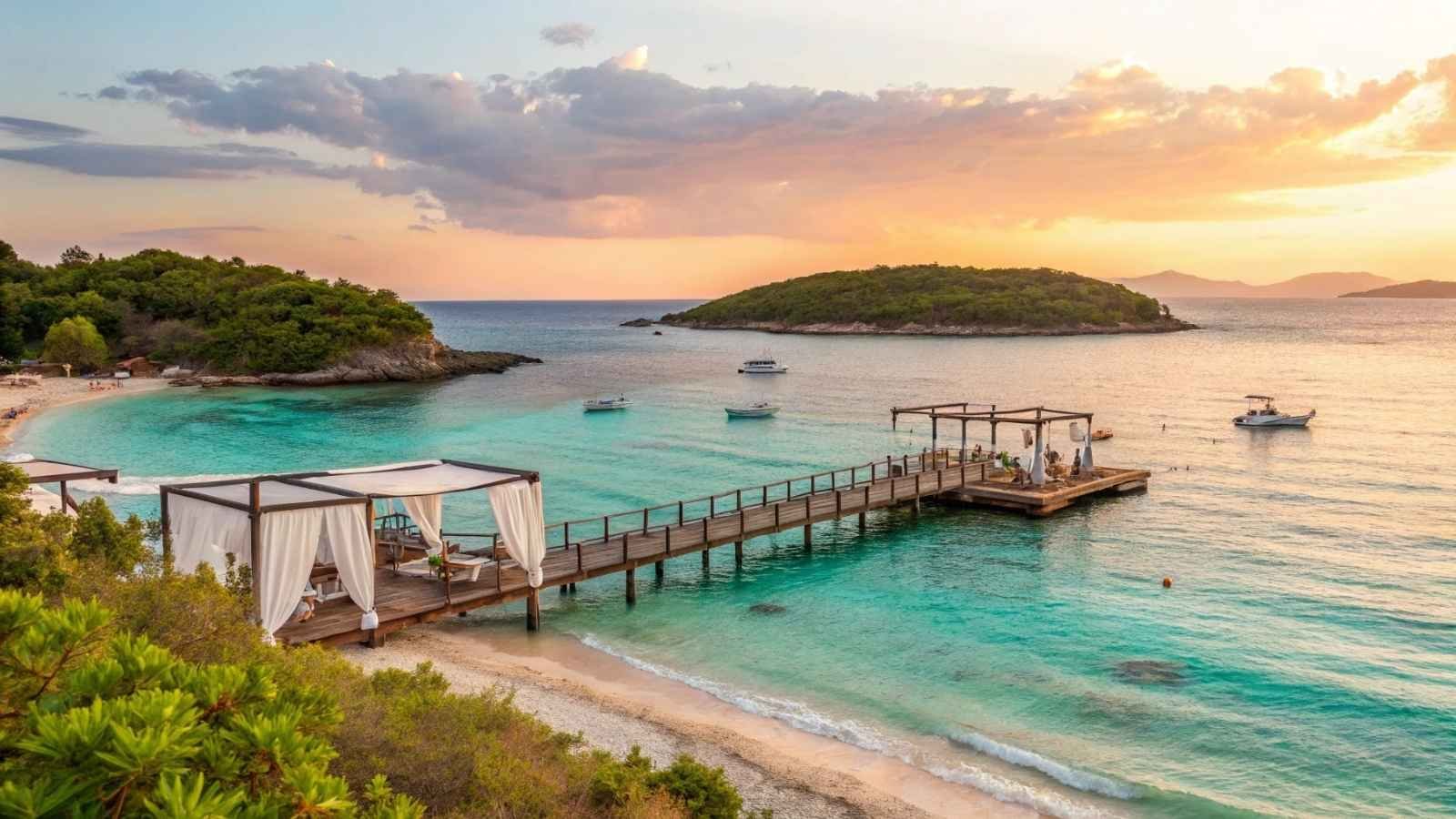
Ksamil feels like a secret that’s slowly leaking out—but not fast enough to ruin it. Tucked along Albania’s Riviera, it’s known for its Caribbean-blue water and white-sand beaches, a rarity in Europe. Small islands sit just offshore, close enough to swim or kayak to, making it feel like you’ve stumbled into your private paradise.
Unlike other Mediterranean hotspots, Ksamil is still refreshingly affordable. Fresh seafood feasts, boat rentals, and beachfront loungers come at a fraction of the cost you’d pay in Greece or Italy. That affordability, mixed with natural beauty, has turned Ksamil into a rising star without losing its laid-back vibe.
Beyond the beaches, you’re just a short drive from the UNESCO site of Butrint, an ancient city filled with Greek, Roman, and Byzantine ruins. It’s rare to find a place where you can swim in turquoise water in the morning and wander ancient amphitheaters in the afternoon. Ksamil delivers both effortlessly.
- Best months to visit: June–September (shoulder season in June/September is quieter)
- Must-try food: Fresh mussels, grilled fish, qofte (Albanian meatballs)
- Don’t miss: Boat trip to the nearby islands
- Nearest airport: Corfu Airport (30-minute ferry + short drive)
5. Cadaqués, Spain
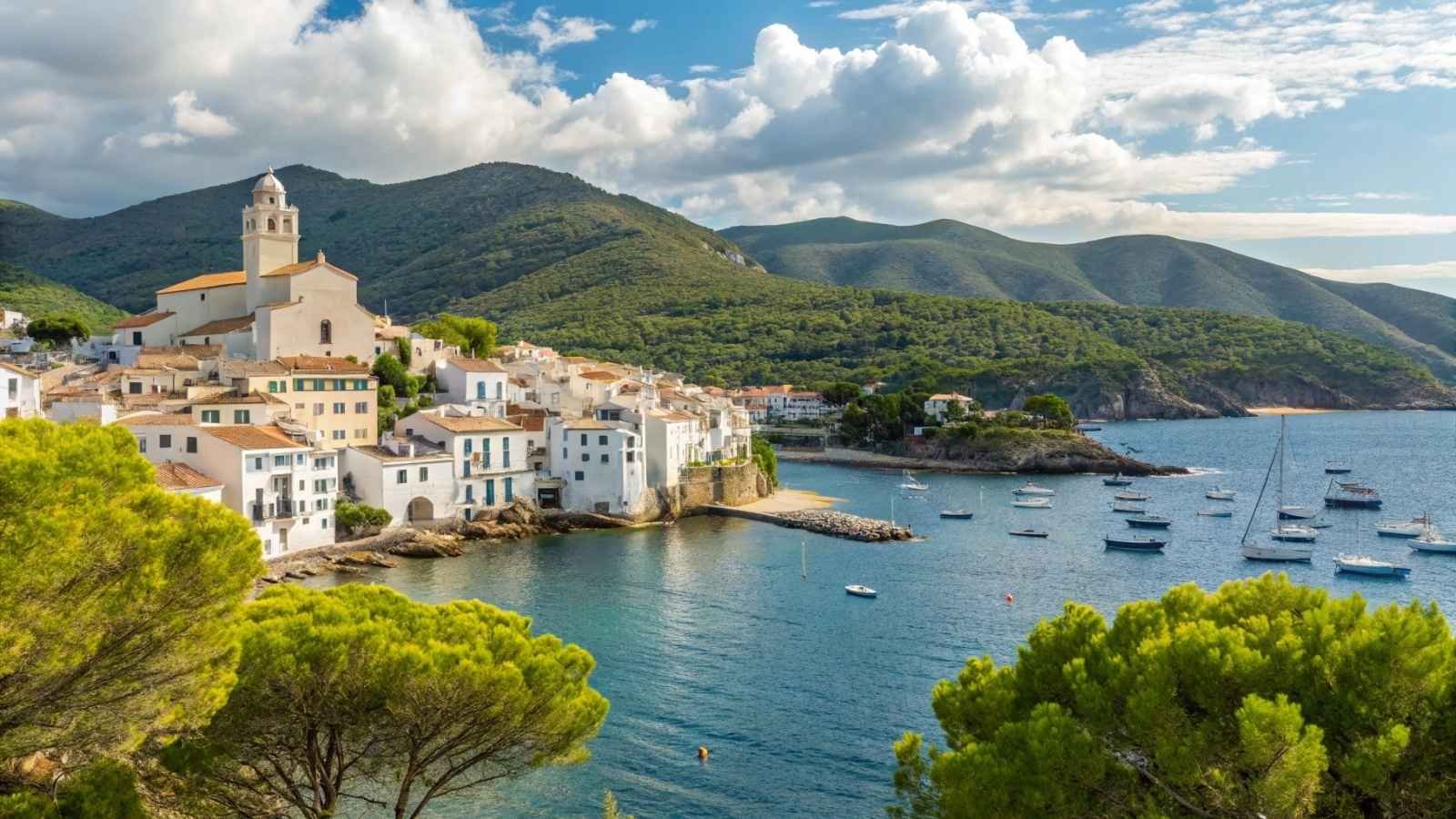
Cadaqués sits on the rugged Costa Brava, and it’s easy to see why Salvador Dalí called it home. The whitewashed houses, cobalt-blue waters, and dramatic rocky coastline create an almost surreal atmosphere. While nearby Barcelona buzzes with energy, Cadaqués remains a quiet haven for artists, dreamers, and those who love unspoiled beauty.
The town’s beaches are smaller and pebbly, but the water is incredibly clear, framed by dramatic cliffs. Wandering the town feels like stepping into a living painting: bougainvillea spilling over balconies, tiny cafés tucked into corners, boats bobbing in the bay. It’s understated and deeply enchanting.
Art plays a big role here. You can visit Dalí’s former home in nearby Portlligat, a quirky and fascinating stop that reflects the surrealist master’s personality. Afterward, spend the evening sipping wine by the sea while the golden Mediterranean light bathes the town in warmth. Cadaqués is beauty in its purest, quietest form.
- Best months to visit: May, June, September (July/August are crowded)
- Must-try food: Suquet de peix (Catalan fish stew), anchovies, cava
- Don’t miss: Dalí’s house in Portlligat
- Nearest airport: Girona Airport (1.5 hours by car)
6. Kotor, Montenegro

Kotor isn’t your typical beach escape—it’s a town where mountains crash straight into the Adriatic, creating one of the most dramatic coastal settings in Europe. The Old Town, wrapped in Venetian walls, is a labyrinth of stone alleys, hidden squares, and centuries-old churches. It feels like stepping back in time, yet the water is always just a few steps away.
The Bay of Kotor is calm, more like a fjord than a traditional beach. Locals swim from stone jetties, sunbathe on pebbled coves, and sip coffee in waterfront cafés. The vibe here is slower, quieter, and deeply romantic compared to Europe’s more obvious seaside destinations.
One of Kotor’s highlights is climbing the city walls up to St. John’s Fortress. From the top, you’ll have an unforgettable view of red-tiled rooftops, turquoise waters, and steep mountains framing it all. It’s a mix of natural and architectural beauty that very few places can rival.
- Best months to visit: May–June, September–October (warmer weather, fewer cruise crowds)
- Must-try food: Njeguški prosciutto, seafood risotto, Montenegrin wine
- Don’t miss: Sunset from St. John’s Fortress
- Nearest airport: Tivat Airport (20 minutes by car)
7. Collioure, France
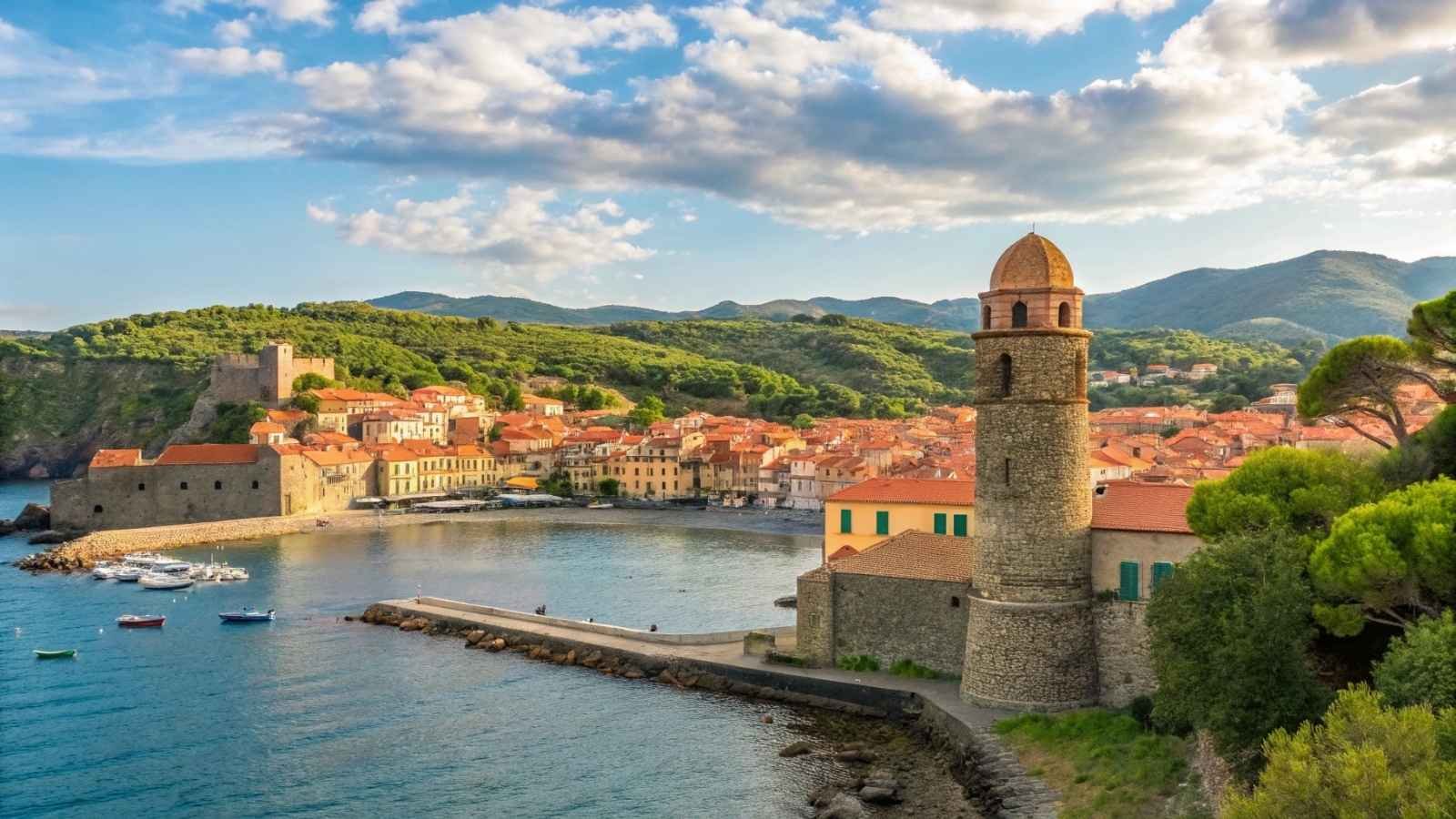
On France’s southern coast near the Spanish border, Collioure is a beach town that feels like a watercolor painting come alive. Bright pastel houses, medieval castles, and fishing boats painted in bold colors create a setting that once drew artists like Matisse and Picasso. It’s a town drenched in light and beauty.
The beaches here are small but incredibly charming, with pebbles giving way to calm, clear waters. Cafés line the waterfront, and there’s a relaxed, almost Provençal-meets-Catalan vibe to the town. The combination of seaside charm, artistic heritage, and wine country just inland makes Collioure a true hidden gem.
Collioure is also famous for its anchovies, which have been cured here for centuries. Pair them with a glass of local Banyuls wine, and you’ll understand why artists found endless inspiration in this town. It’s the kind of place that’s best enjoyed slowly, without an agenda.
- Best months to visit: May–June, September (summer can be crowded)
- Must-try food: Anchovies, grilled seafood, Banyuls wine
- Don’t miss: Château Royal de Collioure and the colorful harbor
- Nearest airport: Perpignan Airport (40 minutes by car)
8. Polignano a Mare, Italy
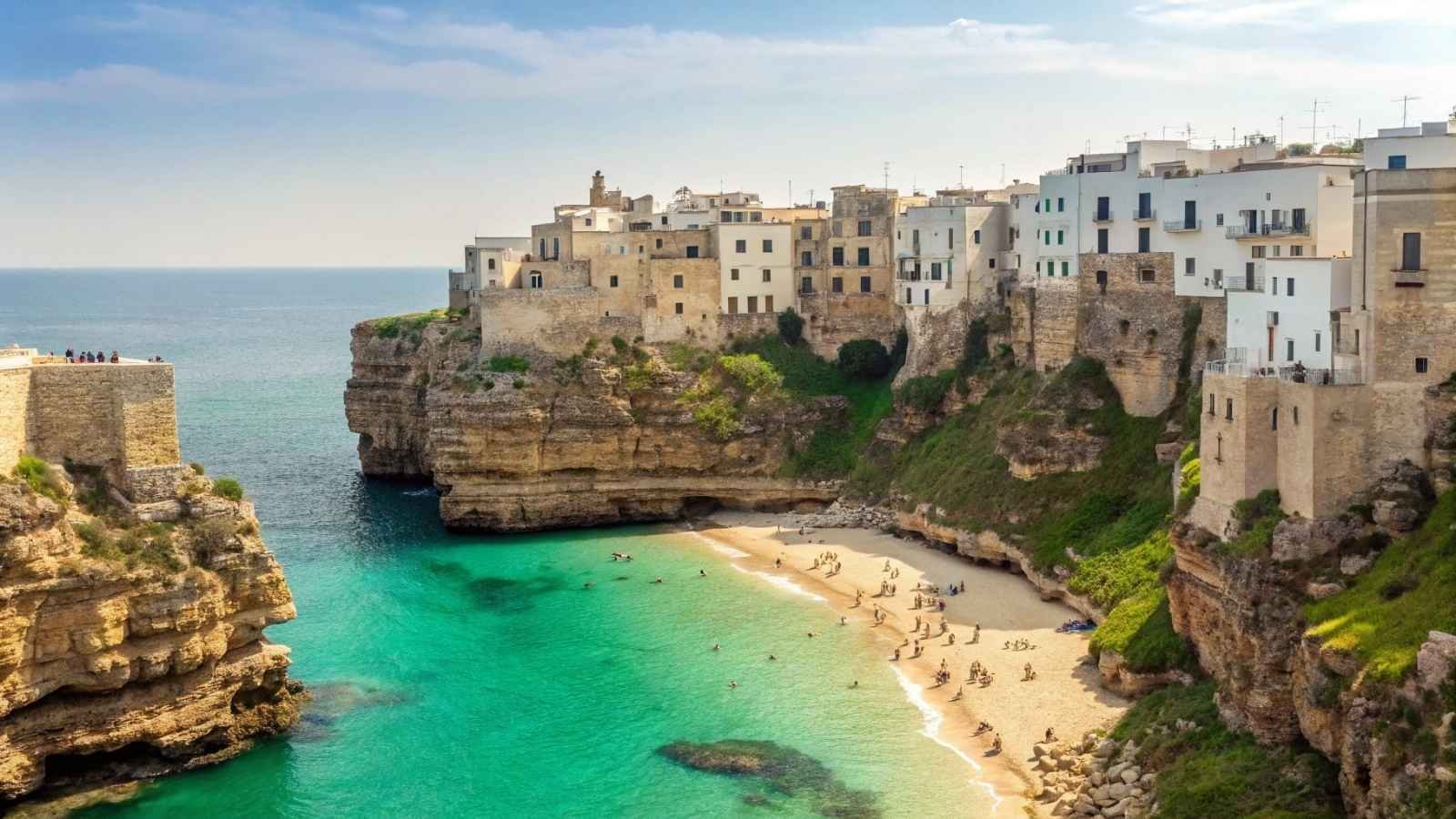
Perched dramatically on limestone cliffs above the Adriatic, Polignano a Mare feels like a town sculpted by the sea itself. Its claim to fame is Lama Monachile Beach, a tiny pebble cove wedged between cliffs, with turquoise water so clear it looks unreal. It’s one of Italy’s most iconic coastal views.
The Old Town is a maze of whitewashed alleys, balconies overflowing with flowers, and terraces with breathtaking sea views. Many restaurants are carved directly into the cliffs, where you can dine while waves crash beneath you. Polignano balances raw natural drama with Italian charm effortlessly.
For thrill-seekers, the cliffs here are famous for cliff-diving competitions. For the rest of us, it’s enough to linger with gelato in hand, watching the sun dip into the Adriatic. It’s a town that feels both exhilarating and soothing at once.
- Best months to visit: May–June, September–October (July/August are very crowded)
- Must-try food: Orecchiette pasta, seafood crudo, gelato with figs
- Don’t miss: Lama Monachile Beach, sea caves by boat
- Nearest airport: Bari Airport (45 minutes by car)
9. Sveti Stefan, Montenegro
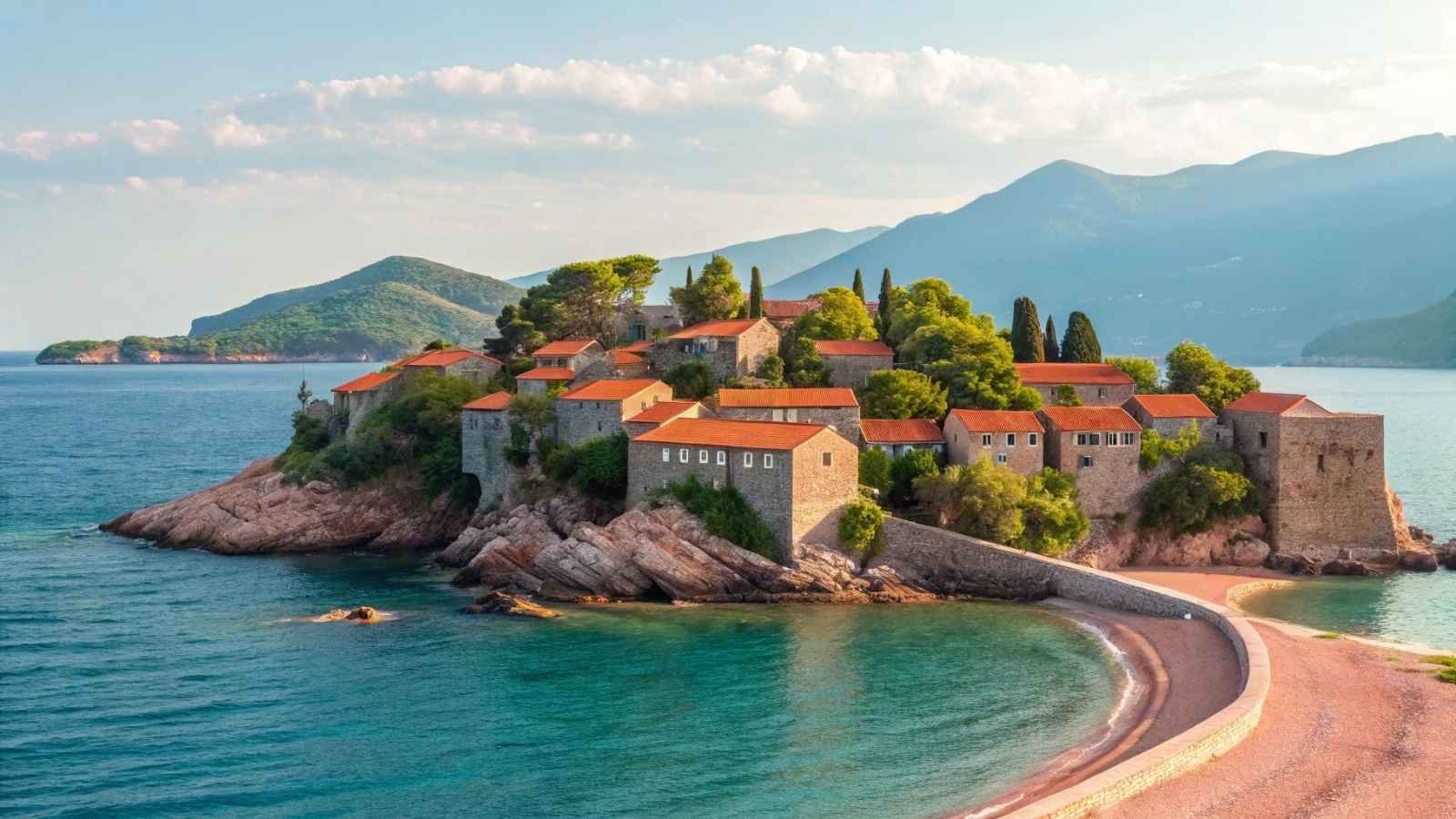
Few beach towns in Europe are as instantly recognizable as Sveti Stefan, a small fortified island connected to the mainland by a narrow causeway. Today, the island is home to an ultra-luxury resort, but the surrounding area offers some of the most stunning beaches in Montenegro.
The town itself is tiny, but the beaches nearby—such as Miločer Beach—are wide, sandy, and framed by lush pine forests. The waters are calm and shallow, making it perfect for swimming. From almost any angle, the island’s terracotta rooftops rising from the sea create a surreal backdrop.
While you can’t freely wander the island unless you’re staying there, simply admiring it from the beaches is part of the charm. It’s a postcard come to life, the kind of view you never get tired of.
- Best months to visit: June–September
- Must-try food: Fresh seafood, Montenegrin cheese, local wines
- Don’t miss: Sunrise or sunset views of the island
- Nearest airport: Tivat Airport (30 minutes by car)
10. Syros, Greece

Syros is often overshadowed by famous Cycladic neighbors like Mykonos and Santorini—but that’s exactly why it feels so special. The capital, Ermoupoli, is unlike any other Greek island town, with neoclassical mansions, marble squares, and a lively local scene that runs year-round.
The beaches here are stunning yet low-key. Galissas and Kini are favorites, offering golden sands and calm waters without the shoulder-to-shoulder crowds found on more famous islands. The mix of authentic Greek culture and quiet beach life is what sets Syros apart.
At night, the town comes alive with locals dining by the sea, bouzouki music echoing through the streets, and a real sense that this is a living, breathing island, not just a tourist backdrop. It’s a Greek island that still belongs to the Greeks—and that’s rare.
- Best months to visit: May–June, September (pleasant weather, fewer crowds)
- Must-try food: Loukoumi (Greek delight), grilled octopus, and caper dishes
- Don’t miss: Ano Syros, the hillside medieval village
- Nearest airport: Syros Airport (Athens connection flights)
11. Saint-Jean-de-Luz, France
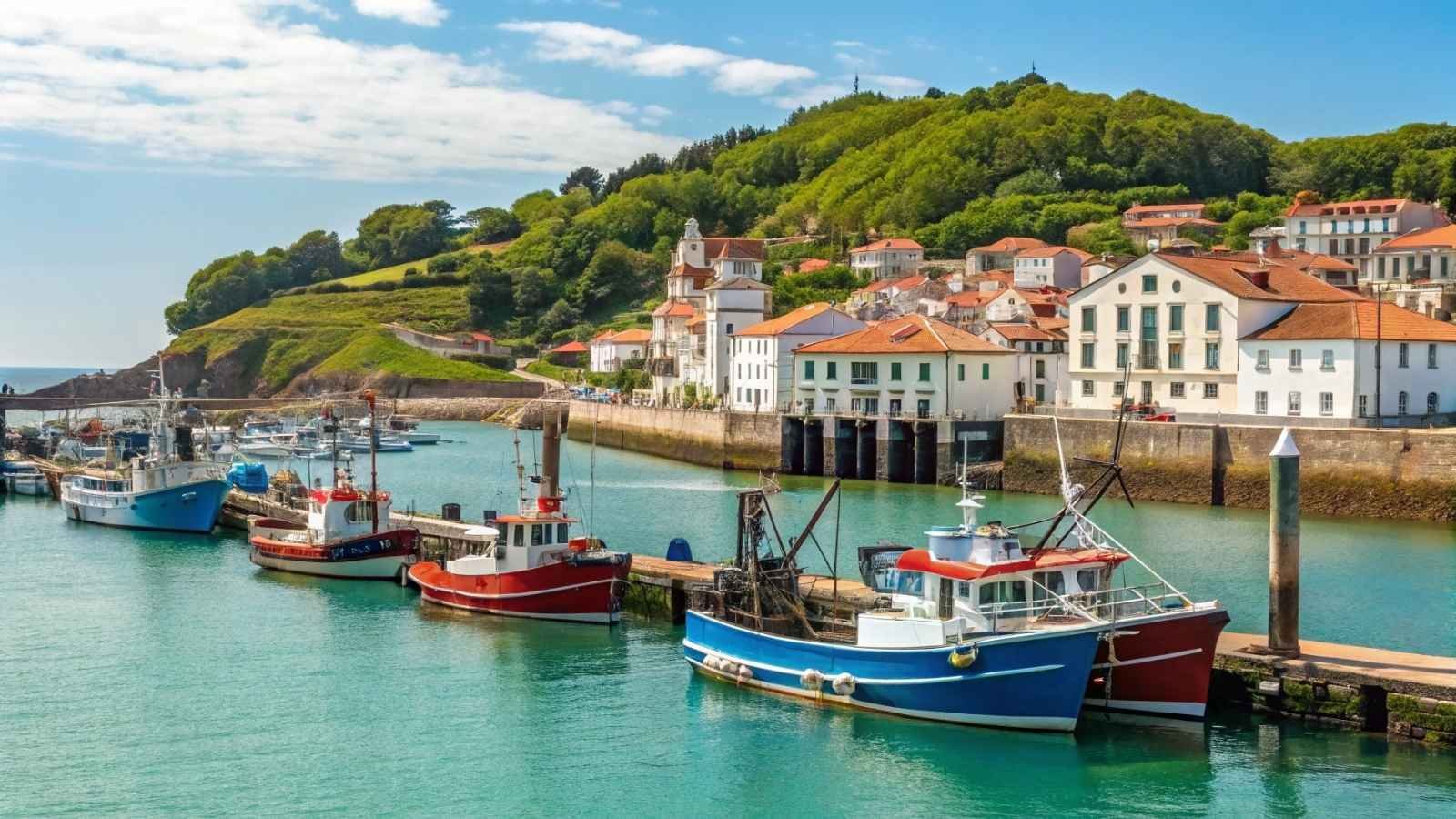
If there’s one town that captures the essence of the French Basque coast, it’s Saint-Jean-de-Luz. Unlike the glitzy vibe of nearby Biarritz, this seaside escape feels more grounded and authentic. Its crescent-shaped sandy bay is protected from the Atlantic’s rough waves, making it one of the most family-friendly beaches in the region.
The town’s heart beats in its market halls and narrow lanes lined with Basque houses—white facades trimmed in deep reds and greens that glow under the summer sun. Cafés spill out onto cobbled streets, serving up rich Basque pastries and seafood straight off the boats. There’s a balance here between everyday life and holiday atmosphere that keeps it irresistibly charming.
What sets Saint-Jean-de-Luz apart is how it feels at once lively and intimate. You can spend the morning lounging on a calm beach, the afternoon exploring the cultural richness of Basque traditions, and the evening swept up in the sound of street musicians. It’s a cultural immersion wrapped in a coastal escape.
- Best months to visit: June–September (August can be crowded but vibrant)
- Must-try food: Basque gâteau, chipirons (small squid), Irouléguy wine
- Don’t miss: Les Halles market for Basque treats
- Nearest airport: Biarritz Airport (20 minutes by car)
12. Piran, Slovenia
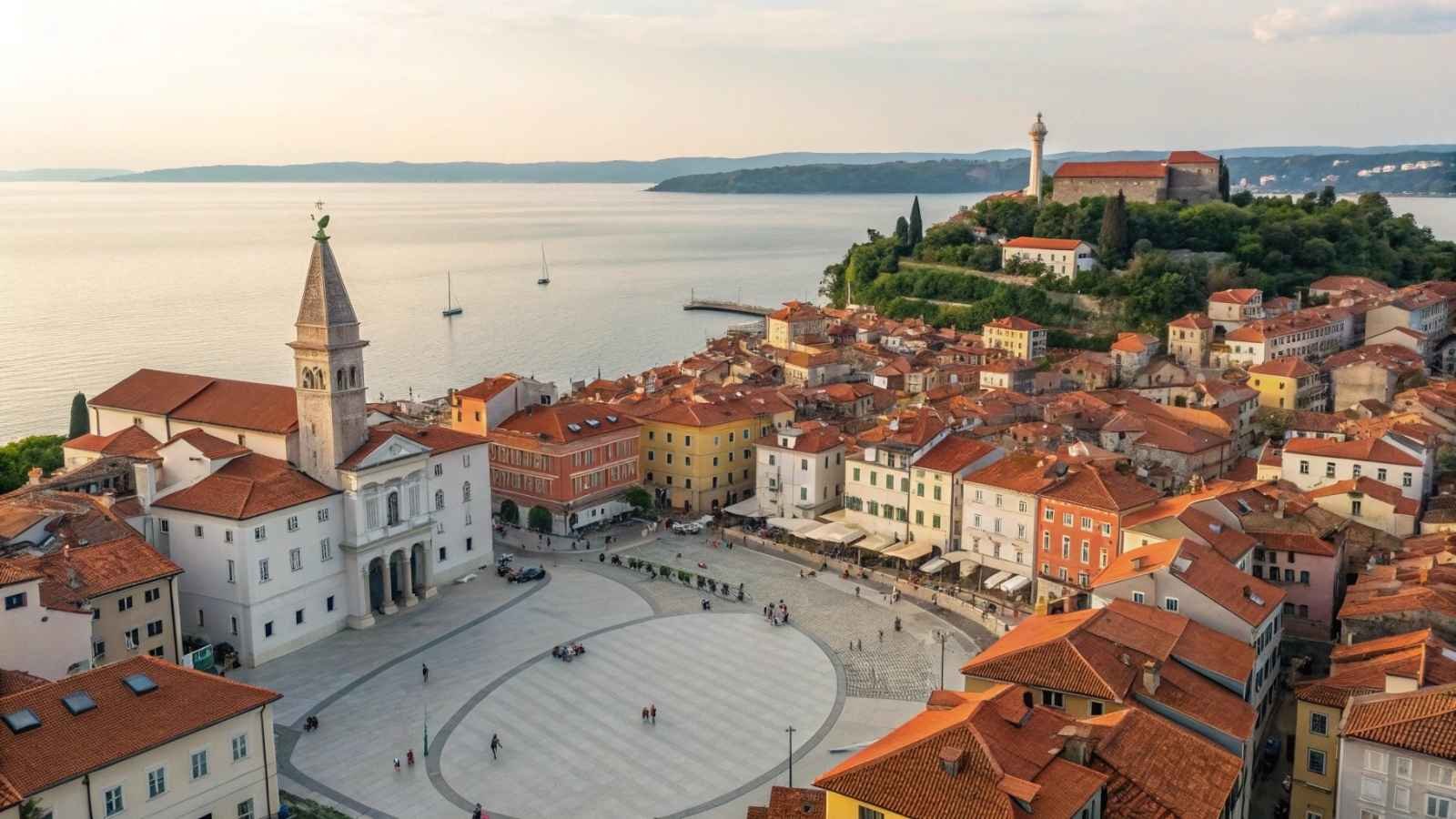
Piran is often called the “Venice of Slovenia,” but that doesn’t quite do it justice. While it shares Venetian-style architecture and pastel-colored houses, it has a character entirely its own—quiet, compact, and wrapped by the Adriatic Sea on nearly all sides. From the town walls, you’ll see terracotta rooftops plunging toward sparkling blue waters, a view that feels almost cinematic.
Instead of wide sandy stretches, Piran’s coastline is all about stone promenades and swimming piers, where locals dive straight into the sea. The water is crystal-clear, perfect for snorkeling or just floating under the sun. In the evening, the town slows down beautifully—cafés along Tartini Square glow with golden light while the sound of church bells drifts across the harbor.
What makes Piran truly special is the sense that it’s both historic and timeless. Venetian influences are everywhere, from ornate windows to seafood-heavy menus, but the pace is pure Slovenia: unhurried, welcoming, and refreshingly affordable compared to much of the Adriatic. It’s the kind of place that doesn’t shout for attention—it quietly wins your heart.
- Best months to visit: May–June, September–October (pleasant weather, fewer tourists)
- Must-try food: Fresh Adriatic squid, salt from nearby Sečovlje, local Malvazija wine
- Don’t miss: Sunset from the old city walls
- Nearest airport: Trieste Airport, Italy (45 minutes by car)





